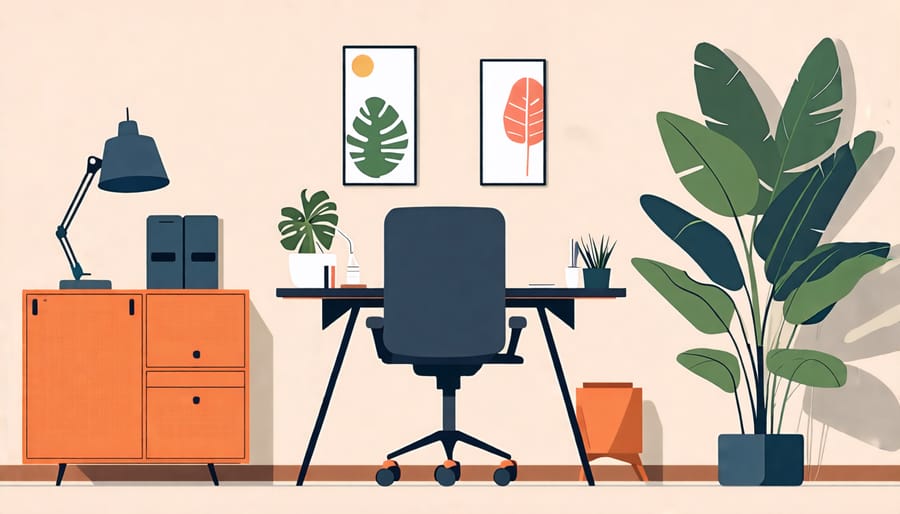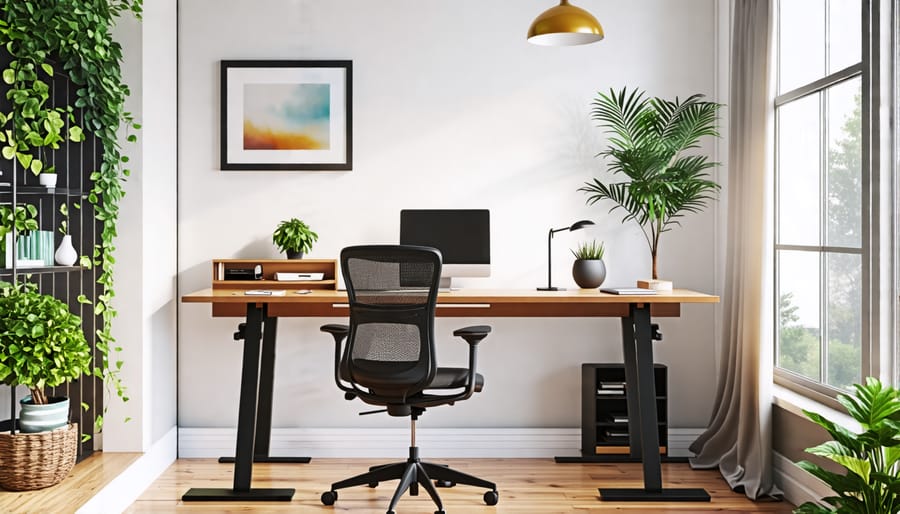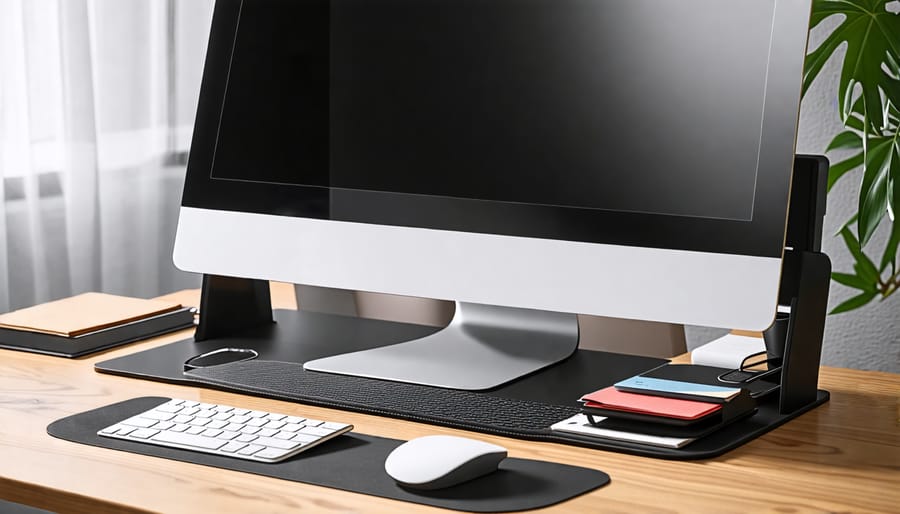Transform your home office with a standing desk by first optimizing your workspace layout. Position your desk near a window to harness natural light, boosting both mood and productivity. Arrange storage solutions strategically around your desk to maintain a clutter-free environment, allowing easy access to essentials without compromising movement. Incorporate adjustable seating options to transition smoothly between sitting and standing, promoting a dynamic workflow that aligns with ergonomic practices. Enhance your setup with personalized elements like plants or artwork to create an inspiring atmosphere that fuels creativity. For additional guidance, explore tips for working remotely to further refine your home office experience.
Why Choose a Standing Desk?
Health Benefits
Switching to a standing desk in your home office can bring significant health benefits, making it a wise choice for your workspace. One of the primary advantages is a reduced risk of back pain. When you stand, your spine is encouraged to maintain its natural curvature, promoting better posture. This shift from sitting to standing counters the tendency to slouch, which can lead to discomfort over time. Moreover, standing desks can help in reducing the risk of chronic issues associated with prolonged sitting, such as cardiovascular disease. By incorporating regular movement into your day, you can also enhance your energy levels and focus, boosting productivity. The transition doesn’t have to be drastic; start by alternating between sitting and standing, and notice how your body responds. Your home office layout can adapt easily to a standing desk while bringing these health benefits, turning it into an inviting, ergonomic haven.
Boosting Productivity
Incorporating a standing desk into your home office is a game-changer that can significantly enhance your productivity levels. When you’re standing, your heart pumps more blood, increasing oxygen flow to your brain and boosting alertness. This can help you maintain focus and energy throughout your workday, making it easier to breeze through your tasks. Switching between sitting and standing positions helps to reduce fatigue, keeping your mind sharp and your creativity flowing.
Moreover, a standing desk encourages movement, which can lead to a healthier posture and reduce the aches associated with prolonged sitting. This movement contributes to a more dynamic work environment, helping you stay engaged and less likely to fall into a productivity slump. By thoughtfully integrating a standing desk, you tailor your workspace to better suit your needs and preferences, which can ultimately boost your productivity and enhance your work-from-home experience.
Creative Home Office Layouts with Standing Desks
Maximizing Small Spaces
Arranging a standing desk in a small space might seem challenging, but with a few strategic tips, you can create a comfortable and efficient home office nook. First, consider the positioning of your desk. Placing it near a window can not only make the area feel more open but also provide natural light, which enhances productivity and mood. Additionally, using vertical space is key. Install shelves above your desk to hold supplies or personal items, keeping your workspace decluttered and visually appealing.
Invest in a wall-mounted foldable desk if your space is extremely tight, as it offers functionality without permanently occupying floor space. You can easily tuck it away when not in use. Opt for a minimalist standing desk design that blends well with your existing décor. Choosing lighter colors for both the desk and surrounding walls can greatly help to make your room look bigger. Also, consider using a corner layout to maximize unused or awkward spots, transforming them into productive areas.
Finally, ensure your standing desk is set to the proper height for comfort, roughly at elbow level. Pair your setup with an anti-fatigue mat for support during long work sessions. With these tips, your small space can become a dynamic hub of creativity and efficiency.

Combining Style and Functionality
Creating a home office that balances style and functionality with a standing desk is an exciting endeavor. Start by selecting a desk that complements your home’s aesthetic. Opt for a design with clean lines and a finish that blends seamlessly with your existing decor, whether it’s rustic wood, modern metal, or chic glass.
Consider adding personal touches that make the space uniquely yours. A colorful area rug can define the workspace while providing comfort for your feet. Pair your desk with adjustable stools or ergonomic chairs for the moments you prefer sitting. To enhance aesthetics, incorporate decorative storage solutions like woven baskets or sleek shelves that keep clutter at bay and maintain a tidy environment.
Lighting is another key element. Position your standing desk near a window to utilize natural light, which boosts mood and productivity. Supplement with stylish task lighting, like an adjustable lamp or wall sconce, to keep your space well-lit during late work hours.
Finally, personalize the area with inspiring artwork or vision boards that fuel creativity and motivation. By harmonizing design elements and functional features, your home office can become a hub of productivity and style that fits perfectly within your living space.

Flexible Layouts for Shared Spaces
Integrating a standing desk into a shared space can be a breeze with a bit of creativity. To start, consider a corner or a niche that allows easy access while maintaining the room’s flow. Using multi-functional furniture can help, like a standing desk that easily adjusts or folds away when not in use. This ensures that the space remains open and flexible for other activities. Experiment with mobile standing desk options that can be rolled into different areas depending on need. By focusing on light colors and minimal clutter, you can seamlessly design the perfect workspace without compromising your room’s comfort and aesthetics.
DIY Standing Desk Setup Guide
Materials and Tools Required
To set up a standing desk in your home office, you’ll need some essential materials and tools. Start with a sturdy desktop—reclaimed wood or a sleek laminate could be a stylish choice—and an adjustable desk frame suited to your height. A drill and screwdriver will come in handy for assembly, while a level ensures that your desk is perfectly balanced. Don’t forget a comfortable anti-fatigue mat, which offers great support for long periods of standing. Cable management tools like clips or sleeves are excellent for keeping cords tidy and out of sight. Lastly, ensure you have a chair for when you need seated breaks, blending function with versatility in your workspace.
Step-by-Step Instructions
Creating the perfect home office setup with a standing desk is both an art and a science, and with a bit of DIY spirit, you can craft your ideal workspace. Begin by selecting the location. Choose a well-lit spot with natural sunlight if possible, as this aids productivity and contributes to a pleasant atmosphere. Measure your space to ensure that your standing desk fits comfortably without overwhelming the room.
Next, focus on the desk itself. If you’re working with a pre-purchased standing desk, assemble it carefully following the manufacturer’s instructions. For those who are keen on a DIY approach, consider building your standing desk using adjustable legs or a crank system to allow for easy height adjustments. This customization ensures that your desk is tailored to your specific ergonomic needs, reducing strain and promoting comfort.
Once the desk is ready, think about the organization. Place cable management solutions like clips or trays underneath or behind the desk to keep wires neatly tucked away, avoiding a cluttered look. Strategically position your monitor at eye level to maintain a healthy posture. If space allows, add shelves above your desk for additional storage and to keep frequently used items within arm’s reach.
Integrate personal touches to inspire creativity and comfort—plants, photos, or motivational prints can add charm without distracting from work. Lastly, test your setup. Adjust the height settings through the day to alternate between sitting and standing. This flexibility can enhance concentration and energy levels, creating a truly dynamic workspace that meets your evolving needs daily.
Expert Tips for Optimizing Your Standing Desk Experience
Ergonomics and Accessories
When setting up your standing desk, consider ergonomics to enhance comfort and productivity. Start with adjusting your monitor so it’s at eye level, reducing neck strain. Opt for a keyboard and mouse positioned so your elbows form a 90-degree angle, promoting a natural posture. Consider using an anti-fatigue mat to lessen leg fatigue during long standing periods. Accessorize with cable organizers to keep your workspace tidy, and add a desk lamp with adjustable brightness for better lighting during late hours. Personal touches like a small plant or motivational art can make the space inviting and boost creativity.

Maintaining Movement
Using a standing desk in your home office is a fantastic way to enhance your productivity and well-being, but it’s important to incorporate movement to prevent fatigue. Start by alternating between sitting and standing throughout the day, perhaps using a timer to remind you to switch every 30 minutes. Incorporate gentle stretches or short walks to keep your muscles engaged and your mind refreshed. A balance board or anti-fatigue mat can also encourage subtle movements and reduce strain on your legs. Remember, the key is variety; small steps like these effortlessly blend movement into your routine while promoting better posture and energy levels.
Conclusion
Incorporating a standing desk into your home office can transform your work habits by enhancing productivity, boosting energy, and promoting better posture. The journey to optimizing your workspace is a delightful blend of creativity and practicality. Whether you’re a homeowner or a renter, experimenting with different desk layouts and configurations can lead to a setup that perfectly suits your needs. Don’t be afraid to try out various height adjustments or pair your desk with ergonomic accessories. By blending form and function, you can craft a workspace that’s not only efficient but also reflects your personal style, ensuring your home office is a place of comfort and inspiration.
